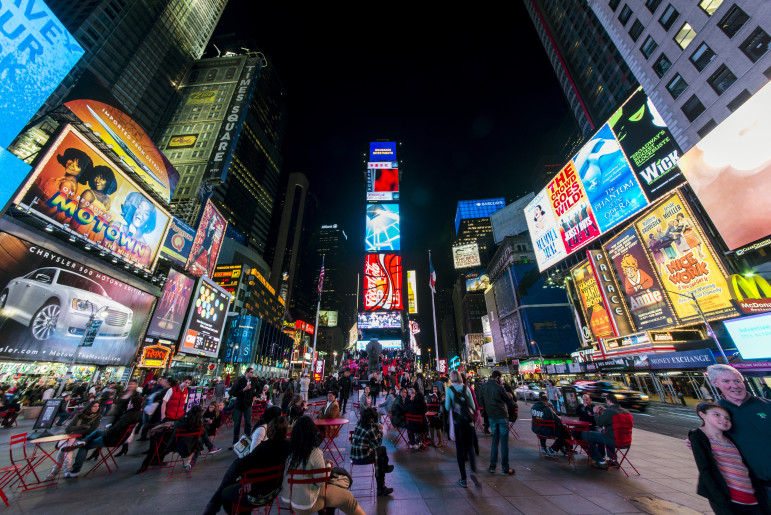
When NYPD police commissioner Bill Bratton recently suggested tearing up the public plaza in Times Square to prevent topless female performers from (legally) hanging out there, he caused quite a stir. Overflowing with tourists and ads, Times Square is an economic engine but also a symbol of the “taking back” of public spaces from the shadow of the city’s crime-ridden past.
Times Square was the ultimate public space to reclaim. The Times Square Alliance, formerly known as the Times Square Business Improvement District (BID), teamed up with then-mayor Rudy Giuliani and a younger Bill Bratton in the early 90’s to “clean-up” the area of many of the undesirables: porn shops, so-called hustlers and the homeless.
This was part and parcel of the Broken Windows theory, the aggressive policing of low-level infractions and “disorder.” Bratton and Giuliani promised to reclaim public spaces and fight disorder, as defined by George Kelling and James Q. Wilson, co-authors of the Broken Windows theory.
In 2009, writing for the Manhattan Institute’s City Journal magazine, Kelling expanded on the early influences of his Broken Windows theory. An early advocate for a strong response to “uncontrollable predators” like “graffitists” was Nathan Glazer, a sociologist who worked in the Kennedy administration and founded an influential policy journal, The Public Interest. Like other liberals who Kelling says influenced his theory—Jane Jacobs being another—Glazer was a Democrat whose ideas dovetailed with conservatives like Kelling. (Glazer’s daughter, Elizabeth, now heads Mayor de Blasio’s office of criminal justice.)
Others, like the head of a Broadway theater organization, pushed the notion of cleansing the square of quality of life nuisances, leading to the permanent institutionalization of order-maintenance policing—what became known as Broken Windows.
“Giuliani and Bratton also gave the force’s members a clear vision of the ‘business’ of the NYPD and how their activities contributed to it. In short, a theory previously advocated largely by elites filtered down to—and inspired—line police officers”, Kelling wrote.
Those ideas continue to resonate in the city, even in liberal hands. For over a year residents in Queens have been fighting the creation of a business improvement district in the area championed by progressive Councilmember Julissa Ferreras. Queens Neighborhoods United, a coalition of mostly immigrant neighbors, fought Ferreras’ plans, backed by the city, over fears that the BID would invite even more aggressive policing and further gentrify their neighborhoods.
Everything old is new again as the city pushes a recycled version of “community policing” while a media-driven chorus clamors for a return to the Giuliani days.
But ensuring that business interests are served by the city, through task forces and crackdowns, is a bi-partisan staple. The TSA, protecting the interests of corporate behemoths like Disney, wields incredible power in the city that the poor, and certainly the homeless, cannot. Self-described progressives like de Blasio and Ferreras will answer the business calls, ultimately.
That, and not some disingenuous talking points about “public spaces,” is the bottom line. The pedestrian plaza that one of the richest men in the world, Mayor Bloomberg, built in Times Square is a public space through the eyes of the elite. The Alliance prefers it “public” for the sake of deep-pocketed tourists and full shopping bags—but not so public that street performers can sully the unbroken windows of Disney or the Hard Rock Cafe.
The outrage over Bratton’s remarks reveal either a cynical or naive take on this reality of business-friendly public spaces. Are the people who want pedestrian plazas and bike paths—mostly the white liberal crowd—ready for the aggressive human cleansing that comes with it?









2 thoughts on “Op-ed: Broken Windows, Topless Ladies and the New Times Square”
There may be an argument here but it eludes me. Assertion piled on assertion (some hidden behind subordinate clauses). The author, it feels to me (but I cannot be sure), is sneering at “the white liberal crowd” Why? Does the author favor pedestrian malls like the one in Times Square? (I do. but then maybe in the view of the author maybe I’m a member of the white liberal crowd. How about the Puerto Rican right wing crowd — Sen. Ruben Diaz, Sr.)? Does the author oppose “Broken Windows” policing? Why is outrage over remarks of a commissioner “either a cynical or naive take on this reality”?
Large office tenants are fleeing the Times Square area, in part because of the awful plazas.
“And law firm Skadden Arps is also fleeing 4 Times Square when its lease
is up in 2019 — leaving at least the possibility of an empty, 1.6
million-square tower by 2020.’
http://nypost.com/2015/08/21/the-business-fears-behind-the-sudden-times-square-furor/